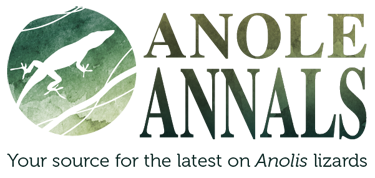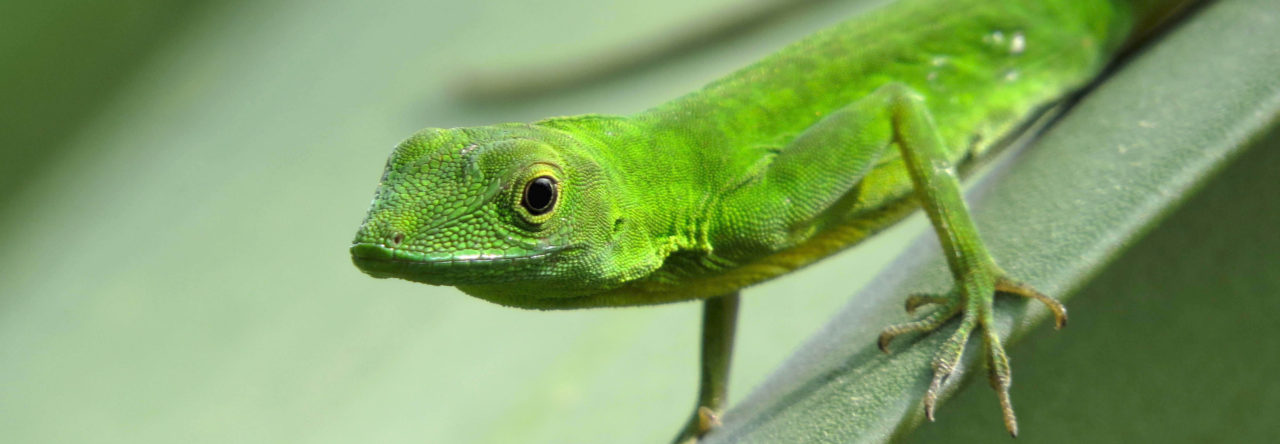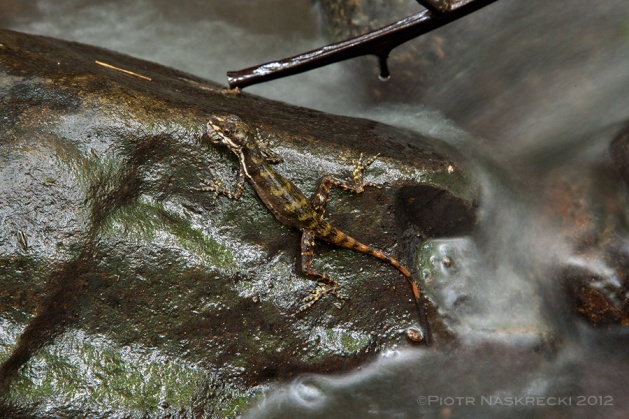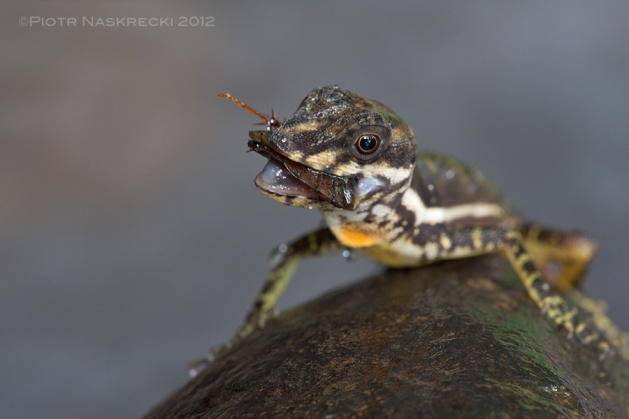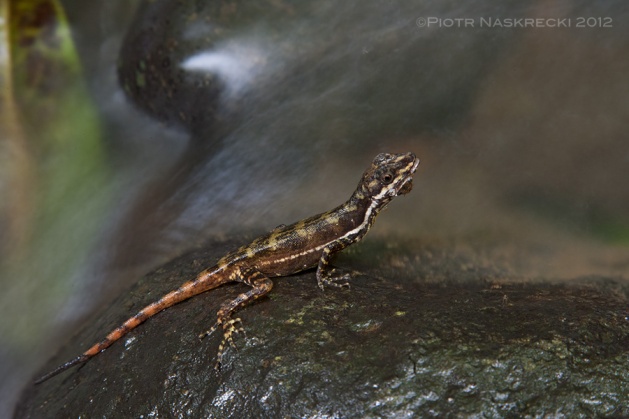Any congress advertising with a horned anole (Anolis proboscis) must be worth attending. Check out the details at the conference website.
Category: All Posts Page 66 of 148

A new paper in Zootaxa aims to figure it out, based on the travel journals of its describer, Franz Werner. Here’s the paper’s abstract:
The eminent Austrian zoologist Franz Werner described several new species of amphibians and reptiles from America, including Anolis aequatorialis Werner, 1894 and Hylodes appendiculatus Werner, 1894. Both species were described based on single specimens, with no more specific type localities than “Ecuador” (Werner 1894a,b). After its description, A. aequatorialis remained unreported until Peters (1967) and Fitch et al. (1976) published information on its distribution and natural history. Anolis aequatorialis is currently known to inhabit low montane and cloud forest on the western slopes of the Andes from extreme southern Colombia to central Ecuador, between 1300 and 2300 m elevation (Ayala-Varela & Velasco 2010; Ayala-Varela et al. 2014; Lynch et al. 2014; D.F. Cisneros-Heredia pers. obs.). Likewise, Hylodes appendiculatus (now Pristimantis appendiculatus) remained only known from its type description until Lynch (1971) and Miyata (1980) provided certain localities and information on its natural history. Pristimantis appendiculatus is currently known to occur in low montane, cloud, and high montane forests on the western slopes of the Andes from extreme southern Colombia to northern Ecuador between 1460 and 2800 m elevation (Lynch 1971; Miyata 1980; Lynch & Burrowes 1990; Lynch & Duellman 1997; Frost 2016). To this date, the type localities of both species remain obscure. The purpose of this paper is to restrict the type localities of Hylodes appendiculatus Werner, 1894 and Anolis aequatorialis Werner, 1894 based on analyses of the travel journals of their original collector.
Among their many contributions to evolutionary biology, anoles have historically been at the forefront of research on sexual dimorphism. Much of the recent work in this area focuses on a very general question – how do males and females express different phenotypes despite sharing essentially the same underlying genome?
Not surprisingly, the answer often depends on the type of scientist you ask. An endocrinologist might say that the development of sexual dimorphism requires hormones such as testosterone and estradiol. A quantitative geneticist might reply that it involves the reduction of genetic correlations between the sexes. A molecular geneticist might view the problem as one of regulating the expression of shared genes differently in each sex. Can anoles help us put these different perspectives together into a unified framework for sexual dimorphism?
To address this question, our lab at the University of Virginia teamed up with Christian Cox (Georgia Southern), Joel McGlothlin (Virginia Tech), and Daren Card, Audra Andrew, and Todd Castoe (University of Texas, Arlington). The full details are available in The American Naturalist, but here’s a quick rundown of the highlights:
We conducted a breeding study on a captive colony of Anolis sagrei, a species in which adult males average nearly three times the mass of females. We found that the extent to which males and females share heritable variation for body size starts out high early in life, but declines rapidly as sexual dimorphism emerges during development.
 This breakdown of genetic constraint is mirrored by a sharp increase in the sex-biased expression of hundreds of autosomal genes in the liver, particularly those genes that regulate growth, metabolism, and cell proliferation. In other words, although male and female anoles share most of the same genes, each sex tweaks the expression of these genes in different ways as development progresses.
This breakdown of genetic constraint is mirrored by a sharp increase in the sex-biased expression of hundreds of autosomal genes in the liver, particularly those genes that regulate growth, metabolism, and cell proliferation. In other words, although male and female anoles share most of the same genes, each sex tweaks the expression of these genes in different ways as development progresses.
How do they do it? We also show that some of the patterns of male-specific gene expression that emerge later in life can be induced by treating juvenile females with testosterone. Putting these pieces together, we propose that hormones help male and female anoles regulate their shared genes in different ways, which allows them to attain dramatically different body sizes and also helps break down genetic correlations that would otherwise constrain their independent evolution. We hope that our study encourages other Anolis biologists to continue building connections between evolutionary genetics, developmental biology, and endocrinology!
Several years ago, I wrote a series of papers and blog posts about the diversity of anole head shape and its developmental origins. My colleagues and I touched on disparate topics such as whether the head differences among species are similar to post cranial ecomorphology, whether the patterns of cranial modularity are conserved across anoles, and the developmental bases of sexual dimorphism in skull shape.
Since starting my own lab at Loyola University in Chicago last year, I am revisiting these projects on skull evolution. Like in much of science, I have found that my early forays into this area created more questions than answers. Understanding the diversity of skull shape among anoles and other iguanid lizards will be one of the first focal areas of my new lab. We are currently mining museum collections to understand how the variation in anole skulls compares to iguanid lizards more broadly. The ultimate goal, however, is to return to questions about the developmental origins of this variation. Just how many different ways has development been modified to generate all the variation we observe in adult anatomy? We do not yet know.
This is where my attention turns to you. To thoroughly flesh out the developmental origins of anatomical diversity, I must have robust sampling of species across the iguanid phylogeny. I am asking the community to please think of me and my students if you have extra breeding animals, eggs, or hatchlings of any species of anole or another iguanid lizard. I am happy to help offset the cost of the animals or collaborate in a mutually beneficial manner.
One of the most exciting species that have recently had the fortune to work with is Anolis hendersoni. For its body size, this species has one of the longest faces of all anoles. In this case I was contacted by the owner of Backwater Reptiles who had several A. hendersoni adults that we are hoping to get eggs from over the next year at Loyola. The folks at Backwater have been great to discuss “exotic” anoles with as they occasionally receive species like A. woodi, A. cybotes, and Chamaeleolis, all of which could be great additions to my project. This is just one example of how I am trying to broaden the sampling for this project. I ask you, the broader anole community, to help me increase my sampling further. I sincerely thank anyone that has leads for me in advance.
I got up early this morning to put a video camera on one of our A. sagrei eggs that was looking particularly ripe. About two hours later, this little hatchling crawled out. The whole hatching process took about 25 minutes, and I’ve sped up the video by 30x. The video is much more compelling with sound. I personally like “Also Sprach Zarathustra,” though “Ranz des Vaches” by Rossini had some enthusiastic support in lab. If you have other music suggestions, add them to the comments!
Happy birthday, little one!
Day’s Edge Productions has produced a great new video about how two species with seemingly identical dewlaps manage to coexist. Manuel Leal explains what’s really going on.
This video originally appeared in bioGraphic, an online magazine from the California Academy of Sciences that features beautiful and surprising stories about nature and sustainability.
What is bioGraphic, you ask? Here’s what it’s webpage says:
A multimedia magazine powered by the California Academy of Sciences, bioGraphic was created to showcase both the wonder of nature and the most promising approaches to sustaining life on Earth. We hope our stories will spark conversations, shift perspectives, and inspire new ideas, helping not only to shed new light on our planet’s most pressing environmental challenges, but also—ultimately—to solve them.
Through an ever-evolving array of storytelling tools and techniques, we will introduce you to some of the world’s most intriguing creatures and inspiring people. We’ll also transport you to faraway places, enabling you to experience what it’s like to be there and what’s at stake for those involved. Along the way, we’ll take a critical look at the environmental issues that pose the greatest threats to our future—and the most promising ideas for addressing them.
So please come along—and come back often—as we travel the globe in search of stories that inspire both awe and hope for a more sustainable future.

Kristin Winchell talks about her studies on urban anole evolution on an interview on PRI.

Hello to everybody, I’m an italian naturalist that visited Cuba last December 2016.
I’m mainly a birder, but I like to give a name to all the creatures I meet. So, I’m going to post 20 pictures of lizards photographed in Cuba: for some I have hypotheses about the identification, but I need confirmation. For some others, I’m completely lost!
Can anybody help me??
Sexual dimorphism, or differences in size or appearance between the sexes, was used by Darwin to explain sexual selection in On the Origin of Species. Interestingly, sexually dimorphic traits, like antlers in deer or showy feathers in peacocks, often do not present themselves until the animals are reproductively mature. Juveniles are often sexually monomorphic, or relatively similar in appearance. Few studies have investigated how sexual antagonism, when different sexes have different optimal strategies, of these traits may develop in the wild over the course of the animal’s maturation. So Aaron Reedy from the Bob Cox Lab at the University of Virginia decided to tackle this question with brown anoles (Anolis sagrei) in Florida.
After tracking thousands of lizards for several generations, Aaron found that selection changed throughout an animal’s life. Adult lizards had selection pressure for large males and small females in one year, but reversed the next, which was surprising, but in both cases was still sexual antagonism. For juveniles, on the other hand, larger body sizes were better regardless of sex. This is an example of sexually concordant selection, where both sexes have similar optimal strategies. He also found that there was selection pressure on the dewlap (an important ornament of anoles in courtship displays) to be smaller in one year, but then reversing the next so that males with larger dewlaps had better chances of survival. This year-to-year variation in selection is interesting and hopefully we’ll learn more from this system in the future.
I’ve recently learned that famous nature micro-photographer Piotr Naskrecki observed an aquatic anole catching prey underwater. Here’s what he had to say on his blog, The Smaller Majority:
The other aquatic iguana
Aquatic iguana (Norops aquaticus) on rocks in a rainforest stream in Costa Rica [Canon 1Ds MkII, Canon 24-105mm]
In a couple of days I am heading off to the Galapagos Islands, where I hope to be able to see the incredible marine iguanas, the world’s only truly marine lizards. Other lizards enter water occasionally, but aquatic lifestyle is quite rare among these reptiles, and few species live and feed under water. But in rainforest streams of Central America there is one little known species of iguana that does just that.I first saw the aquatic iguana (Norops aquaticus) in the southern part of Costa Rica in 1994. These lizards swam and dove in a fast-flowing stream, catching water insects. But when I told a herpetologist friend about it, she refused to believe me.
It took me 13 years to find the aquatic iguana again, and this time I had a camera with me. It was in a different part of Costa Rica (Est. Pitilla in Guanacaste), but the animal and its habitat were the same. I watched it for a couple of hours, following the lizard among slippery boulders, hoping to document its hunting behavior. Eventually I got lucky, but alas, the actual catching of the prey happened underwater, when the iguana cornered a nymph of an aquatic blattodean (a yet undescribed species.) Next time I will definitely try to get a photo of the underwater action.
Update (2 Sept 12): Turns out that the aquatic Norops iguanas that I saw in southern Costa Rica and those from the northern part of the country, shown here, are different species. The animal in the photos is Norops oxylophus, not N. aquaticus. You can read more about the amazing aquatic behavior of N. oxylophus here. (Thanks to Annemare Rijnbeek for pointing me in the right direction regarding the ID of these animals.)
Incidentally, it appears that these lizards are once again being placed in the genus Anolis, where they historically belonged.
